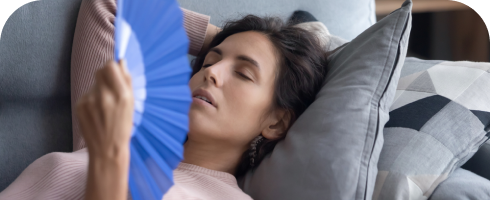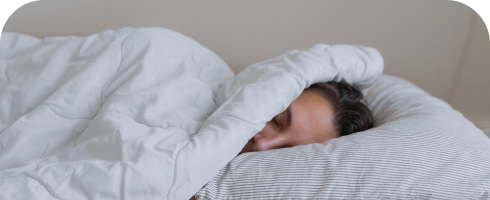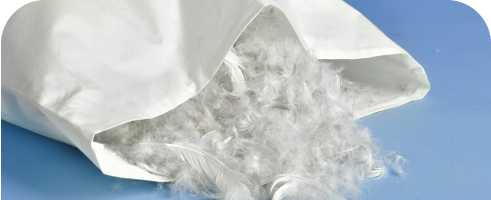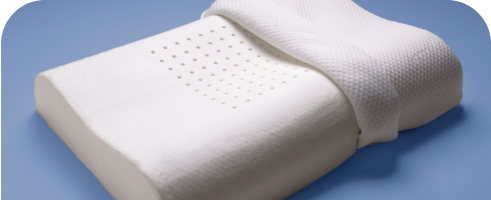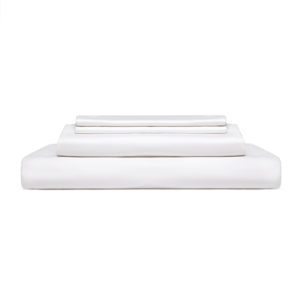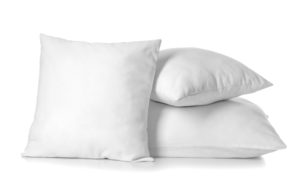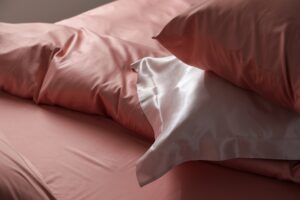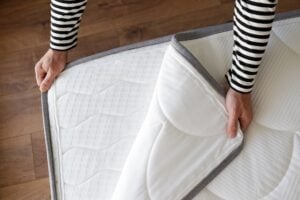How to Shop for Pillows
Key Points
In order to find the best pillow, you’ll need to consider your favorite sleeping position, personal preferences, and budget. The right pillow should support your head and neck and enhance your overall comfort. Picking a pillow that has the right loft, fill material, and shape for your needs can prevent discomfort and increase sleep quality.
With the vast number of pillows available to shoppers, finding the right combination of shape, loft, firmness, and fill material can seem like a daunting task. Thankfully, understanding your sleep habits and personal preferences can help you narrow your search.
We’ll cover the most important aspects of shopping for a pillow, from the features of popular fill materials to how to pick the best loft for your sleeping position. You’ll discover how much you should expect to pay for a pillow and where to find the best deals. You’ll also learn how to spot signs that indicate it’s time for a replacement.
Trouble sleeping?
Answer these 5 easy questions to discover your perfect pillow

Trouble sleeping?
Answer these 5 easy questions to discover your perfect pillow
What position do you sleep in?

Side

Back

Stomach
Why Pillows Matter
The right pillow can help you get a better night’s sleep by supporting your head and neck and keeping you comfortable. Pillows without the right loft and firmness can contribute to muscle strain in the neck and shoulders, which may cause you to wake up with aches and pains. The best pillows promote spinal alignment by properly supporting the head and neck — similar to the way the best mattresses contour, cushion, and support the body.
How to Choose a Pillow
Though some pillow manufacturers market one-size-fits-all pillows intended to work for everyone, choosing the best pillow possible involves taking your individual needs into account. Your budget, sleeping position, body type, and personal preferences are all factors to consider when shopping for a pillow.
Cost
Pillows are available at a wide range of price-points, from as little as $10 to more than $1,000. Style, fill type, cover material, and quality all impact the cost of a pillow. Though well-made options tend to have higher price tags, cost isn’t always indicative of quality. You can find many good options for less than $200, and manufacturers frequently have sales with excellent deals.
Sleeping Positions
Sleep position is among the most important factors to consider when choosing a pillow. While it’s common to change positions throughout the night, consider your preferred sleeping position when pillow shopping.
- Side sleepers: Relatively thick pillows that support the head and neck generally work best for side sleepers. Pillows that are too thin or too soft may allow the head to bend or sink, creating misalignment in the spine.
- Back sleepers: Back sleepers typically do well with medium-loft pillows that are somewhat firm. These pillows provide enough height to keep the head from leaning back but not so much that it tilts forward.
- Stomach sleepers: People who sleep on their stomach tend to prefer soft pillows with low loft, although some don’t use a pillow at all. Thick pillows may put pressure on the neck, causing discomfort.
Loft
Loft refers to a pillow’s height or thickness. People who sleep on their side generally benefit from the thicker profile of a high-loft pillow, while back sleepers tend to prefer mid-loft pillows between 3 and 5 inches thick to avoid tilting the neck at an uncomfortable angle. Stomach sleepers typically like a very thin pillow. Body weight also affects how much a pillow compresses, so sleepers in higher weight ranges may need pillows with more loft.
Temperature Control
A pillow’s fill and cover materials affect temperature regulation more than any other characteristic. Certain fills, such as memory foam, are prone to retaining heat, while others are designed especially for people who sleep hot. If you want a cooling pillow, look for natural fibers, gel infusions, and designs that promote airflow.
“Regulating your core body temperature during the night can make a huge difference in your overall sleep quality, so breathable materials are optimal to promote cooler temperatures. I recommend looking for breathable, natural fibers for bedding, pillows, and cooling sheets, especially if you’re a hot sleeper. Opt for more hypoallergenic materials like cotton, linen, silk, or bamboo, as synthetic fibers tend to be less breathable and trap more heat at night. Your body temperature needs to drop a few degrees to transition to sleep, so having breathable bedding that promotes cooler temperatures is optimal and can help assist with your body’s natural temperature regulation process at night.”
– Sarah Silverman, Psy.D., a licensed psychologist and holistic sleep wellness consultant who treats patients in New York and Florida.
Firmness
Pillows are available in firmness levels ranging from very soft to extra firm. As with loft, your sleeping position and body weight factor into which firmness level is best for your needs. Generally, stomach sleepers benefit from soft pillows, while back and side sleepers are best served by firmer pillows. Keep in mind that firmness is strongly influenced by fill material.
Types of Pillow by Fill
Pillow characteristics change according to their fill type. Two pillows with the same loft and firmness may feel very different if their fill types aren’t the same. Though there are dozens of different fills to choose from, a few types dominate the market.
Down
Often associated with luxury, down pillows have been used for hundreds of years to provide sleepers with a plush sleep surface. Down refers to the fluffy, insulating feathers that grow beneath a bird’s coarser outer feathers. Many down pillows feature goose down, though some down comes from ducks or other waterfowl.
| Pros | Cons |
|---|---|
|
|
Feather
Feather pillows contain the quilled outer feathers of birds such as ducks and geese. That said, they usually include some down. Feather pillows tend to be less expensive and firmer than down-only pillows.
| Pros | Cons |
|---|---|
|
|
Polyester Fiberfill
Polyester fiberfill is a synthetic material that is often labeled as a down alternative because of its softness and lightness. Polyester pillows are generally more affordable than down and may appeal to people who wish to avoid animal products.
| Pros | Cons |
|---|---|
|
|
Memory Foam
Memory foam pillows come in solid and shredded options, both of which are made from polyurethane. Solid memory foam pillows offer structure, while shredded models have greater moldability. Both versions conform to sleepers’ heads and necks to alleviate pressure. Some memory foam pillows have gel or copper infusions that are intended to control temperature, as memory foam typically retains heat.
| Pros | Cons |
|---|---|
|
|
Latex
Natural latex is derived from the same trees that make rubber. It has a buoyant feel and is excellent at relieving pressure while maintaining its shape and structure.
You can purchase latex pillows in both solid and shredded options. Because natural latex is often sustainably sourced, you should expect to pay more for a natural latex pillow than you might for one that uses synthetic latex or another synthetic fill like polyester fiberfill
| Pros | Cons |
|---|---|
|
|
Types of Pillows by Size and Shape
Four of the most common pillow sizes are rectangular, while Euro pillows feature a square design and are often used to accent bedroom decor. There are also numerous specialty options designed to accommodate unique needs like travel, pregnancy, continuous positive airway pressure (CPAP) mask use, and knee pain.
| Pillow Size | Measurements |
|---|---|
| Standard | 20″ x 26″ |
| Super Standard | 20″ x 28″ |
| Queen | 20″ x 30″ |
| King | 20″ x 36″ |
| Euro | 26″ x 26″ |
| Pillow Type | Description |
|---|---|
| Neck Pillow | Neck pillows are designed to keep the cervical spine properly supported. U-shaped travel pillows, designed to support the neck while a person sleeps in a seated position, are also sometimes called neck pillows. |
| Wedge Pillow | Wedge pillows are triangular pillows with one thick edge that gradually tapers off. Many sleepers use them to read in bed or to help relieve symptoms associated with acid reflux or sleep apnea. |
| Pregnancy Pillow | These specialty pillows are designed to take some of the stress off the joints and midsection of a pregnant person. They are available in a range of sizes and designs. |
| CPAP Pillow | CPAP pillows have strategically placed cutouts designed to eliminate uncomfortable pressure from CPAP masks and hosing. They are especially helpful for side sleepers. |
| Knee Pillow | When placed between the knees, this type of pillow can take stress off your joints and help keep your spine aligned. |
| Body Pillow | Typically measuring at least 48 inches long, body pillows provide support and cushioning along the length of the body. |
Where You Should Buy Pillows
You can buy pillows directly from the manufacturer, online from a third-party retailer or marketplace, or from a brick-and-mortar store. Each purchasing method has advantages and disadvantages. Where you should buy your pillow comes down to your personal preferences, individual needs, and what kind of pillow you’re looking for.
| Direct From Pillow Manufacturers | Third-Party Retailers and Marketplaces | In a Store |
|---|---|---|
|
|
|
Purchasing directly from the manufacturer can save you money, especially if you’re looking for a high-end item. However, shopping through a third-party retailer lets you compare models from multiple brands. If you want to try before you buy, purchase your pillow in a brick-and-mortar store.
How Often Should You Replace Your Pillow?
Most pillows need to be replaced after one to two years of regular use. However, fill and cover materials break down at different rates, so some pillows may wear out sooner or last longer. For example, polyester fiberfill pillows tend to wear out within a year, while high-quality latex pillows can last as long as three or four years.
If you keep a pillow for too long, it may sag and fail to provide sufficient support. Bacteria, facial oils, dirt, and allergens can also build up in a pillow, so it’s important to wash your pillow regularly and purchase a replacement when it shows signs of aging.
Signs It’s Time to Replace Your Pillow
Inspect your pillow periodically and look for a few distinct signs that it’s time to replace your pillow.
- Compression: If a pillow has lost its loft, that means the fill materials inside are breaking down and no longer provide the same support level that they once did.
- Lumpiness: If the fill in your pillow is starting to clump together, it’s no longer providing an even sleep surface.
- Discoloration: When your pillow’s cover materials start to yellow, it’s a good indicator that your pillow needs replacing.
- Breakouts or allergy symptoms: Over time, pillows may accumulate bacteria or mildew, which can cause skin breakouts and allergic reactions.

